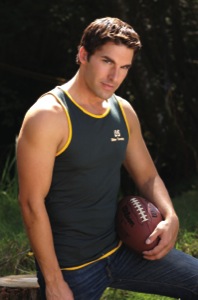
Positive Youth, a 42-minute documentary produced by Logo TV, tells the story of four inspiring young adults whose lives are affected by HIV. Appearing at film festivals across the United States and Canada during the summer, including FilmOut San Diego May 31, Positive Youth shares a message of hope for those living with HIV and helps to educate the public. The DVD will be released July 1 on Amazon.
Today, HIV affects more than 41 million people around the world. Although there is no cure, huge medical advancements have been made in the past 30 years. There are now treatments that can reduce viral loads; lower the risk of transmission; and allow those with HIV to live “normal” lives.
San Diego LGBT Weekly spoke with Charlie David, director of Positive Youth, to learn more about his inspiration for filming the documentary; what he learned in the process; and what he hopes viewers will take away from the film.
San Diego LGBT Weekly: What was your inspiration that prompted Positive Youth?
Charlie David: I was in New York for a meeting with Logo TV and as we tossed around ideas, this concept of doing something on HIV-positive youth came up. It floored me, frankly. That’s how I knew that it was a good idea. The film would look at the question of why is the transmission rate dramatically rising and see if there’s something we could do about it to open the conversation again.
Have you ever been close to anyone who was HIV-positive?
Prior to the film, actually no. It was a big learning curve for me, definitely. I realized that my own sex education on HIV and AIDS was somewhat outdated and there are great thing going on with the medical advancements. It’s changing all the time. There are so many clinical trials going on that we are getting closer and closer to a potential vaccine, which is very exciting. Certainly, on an emotional level I learned a lot by speaking with the subjects in my film; because where we might not have the same fear of dying or as many concerns about the side effects of the drugs that we did in the ’80s and ’90s there’s still a lot of emotional stress.

How did you find the subjects for the documentary?
It was not easy. The biggest thing that people face today is the stigma and the fear of isolation and rejection. I reached out to a lot of people and received quite a few nos. I eventually found my subjects who I think are incredibly brave in opening up their homes and hearts to us about the film. It started in Vancouver; I was there for a film festival last summer and I started asking youth groups and HIV and AIDS resource centers and asking if there was anyone there who would be willing to participate in the documentary. I found Jesse Brown and he graciously helped us out. With Chris Brooks in Orlando, I felt that it was important to find someone in the African American community because the statistics are fairly dramatic in that 68 percent of new transmissions between the ages of 13 and 29 are African Americans. I thought if I didn’t have someone from the black community that I would get a big personal fail. I wanted to make sure that it was as diverse in its presentation as possible.
What do you hope that viewers will take away from this film?
My goal was to have a two-fold message. The first part is for those that are negative in the audience watching to take it as a message of caution. To recognize that although there have been fantastic medical advancements and it may not be a fear of dying and chronic illness anymore, it’s still extremely traumatic having to deal with ongoing treatment in one’s life. And to take the necessary precautions, like with safe sex.
Number two, for people who are positive, that they can have hope. We are showing young, aspirational individuals who are living really exciting and wonderful and positive lives. We wanted to say that even if you are positive, this is not the end of the world. You can have a long and healthy and happy life.
What are some of the more surprising things that someone might learn from the film?
There are many different things. One in 35 young men in the Vancouver area under the age of 30 are positive and don’t know. Or a fact like in the city of New York, in a more gay-centric neighborhood like Chelsea or Hell’s Kitchen, that that statistic is likely closer to be 1 in 2, which is pretty startling. Just that the treatment has really changed from one time when you would be taking up to 60 pills a day to now there being some treatment regimens that are only one pill a day. Also, the fact that someone used to get tested and have to wait for two weeks to find the result. You can imagine what that would be like. You might be positive and you had to stretch it out for two weeks to find the result. Now we have rapid tests and can find the results in 20 minutes.










